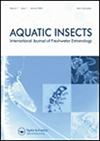Annotated checklist of water scavenger beetles (Coleoptera: Polyphaga: Hydrophilidae) of Morocco
IF 0.6
4区 农林科学
Q4 ENTOMOLOGY
引用次数: 4
Abstract
Abstract A checklist of water scavenger beetles from Morocco and their distribution in the country and North Africa is presented. It is based on (1) an exhaustive review of the literature (time span: 1914–2018); (2) more than 3150 individuals collected during extensive campaigns (2003–2018); and (3) an intensive revision of private collections. We found 52 species belonging to 14 genera and five subfamilies. Paracymus relaxus Rey, 1884 is reported for the first time from Morocco. Four species were excluded from the country’s fauna. A chorological analysis showed that most species found are essentially Mediterranean (48%) and Palaearctic (31%) elements. The subcosmopolitan elements and those whose distribution extends beyond the Palaearctic Region, in the Nearctic or Afrotropical Region, are less represented (21%). Most endemics are halophiles, pointing to the importance of the conservation of saline ecosystems.摩洛哥食水甲虫(鞘翅目:多食目:亲水甲虫科)注释清单
摘要介绍了摩洛哥食水甲虫名录及其在该国和北非的分布。它基于(1)对文献的详尽综述(时间跨度:1914–2018);(2) 在广泛的运动中收集了3150多人(2003-2018);以及(3)对私人收藏进行深入修订。我们共发现52种,隶属于5亚科14属。松弛副cymus relaxus Rey,1884年首次从摩洛哥报道。四个物种被排除在该国的动物群之外。合唱分析表明,发现的大多数物种基本上是地中海(48%)和古北界(31%)元素。次共治区元素以及分布范围超过古北区、在近北区或非洲区的元素的代表性较低(21%)。大多数地方病都是嗜盐性的,这表明了保护盐水生态系统的重要性。
本文章由计算机程序翻译,如有差异,请以英文原文为准。
求助全文
约1分钟内获得全文
求助全文
来源期刊

Aquatic Insects
生物-昆虫学
CiteScore
2.00
自引率
25.00%
发文量
27
审稿时长
>12 weeks
期刊介绍:
Aquatic Insects is an international journal publishing original research on the systematics, biology, and ecology of aquatic and semi-aquatic insects.
The subject of the research is aquatic and semi-aquatic insects, comprising taxa of four primary orders, the Ephemeroptera, Odonata, Plecoptera, and Trichoptera but also aquatic and semi-aquatic families of Hemiptera, Coleoptera, and Diptera, as well as specific representatives of Hymenoptera , Lepidoptera, Mecoptera, Megaloptera , and Neuroptera that occur in lotic and lentic habitats during part of their life cycle. Studies on other aquatic Hexapoda (i.e., Collembola) will be only accepted if space permits. Papers on other aquatic Arthropoda (e.g., Crustacea) will not be considered, except for those closely related to aquatic and semi-aquatic insects (e.g., water mites as insect parasites).
The topic of the research may include a wide range of biological fields. Taxonomic revisions and descriptions of individual species will be accepted especially if additional information is included on habitat preferences, species co-existing, behavior, phenology, collecting methods, etc., that are of general interest to an international readership. Descriptions based on single specimens are discouraged.
Detailed studies on morphology, physiology, behavior, and phenology of aquatic insects in all stadia of their life cycle are welcome as well as the papers with molecular and phylogenetic analyses, especially if they discuss evolutionary processes of the biological, ecological, and faunistic formation of the group.
 求助内容:
求助内容: 应助结果提醒方式:
应助结果提醒方式:


